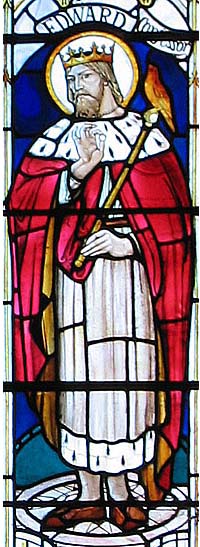
EBK Home
Kingdoms
Royalty
Saints
Pedigrees
Archaeology
King Arthur
Adversaries
Mail David
 St. Edward the Confessor,
St. Edward the Confessor,King of England
(1004-1066)
Edward was the eldest son of King Aethelred the Unred by his second wife, Emma of Normandy. He had six elder half-brothers, so the chances of his inheriting the throne must have been thought slim during his childhood. It became all the more unlikely because of the Danish Conquest of England in 1016, when Edward was twelve. King Aethelred died the same year and Edward's widowed mother married the Danish conqueror, Canute the Great, not long afterward. The little prince's parentage, however, made it advisable for him to remain at his uncle’s court in Normandy. After Canute's death in 1035, the English succession was disputed between the late king’s two sons by his two wives: Harold Harefoot the son of Aelfgitha of Northampton and Hardicanute the son of Emma. Edward made a play for the throne himself, leading an unsuccessful raid on Southampton, while his younger brother, Alfred, landed in England in 1036; but Emma’s English sons received no support from their mother and poor Alfred was even murdered for his trouble. Harold Harefoot established himself as King, and Hardicanute later succeeded him. The latter quickly became unpopular amongst the English ealdormen and, in 1041, Edward was able to return to England and be recognised as his half-brother's heir. He succeeded him after Hardicanute’s sudden death the following year.
Edward's tight control of England was largely due to the powerful family of Earl Godwin of Wessex. Several of his sons became earls and Edward married his daughter, Edith, in 1045. However advantageous this alliance may have been at the time, it is likely that Edward actually harboured a deep-felt grudge against Godwin who had been implicated in the murder of the King's brother. Edward brought many friends from Normandy to England, notably Robert of Jumieges, to whom he gave the diocese of London. In 1050, the King favoured Jumieges over another of the Godwin clan as Archbishop of Canterbury, subsequently allowing his followers to erect castles in the earldoms of Godwin’s sons, Swein and Harold (in Herefordshire & Essex respectively). The following year, Edward's brother-in-law, Eustace of Boulogne, arrived in the country and set about organising the erection of another castle at Dover, part of Earl Godwin's own domain. The people of Dover objected with force, killing nineteen of Eustace's men. Godwin refused to take any action against the men of Kent and the King was thus presented with the excuse he needed to arrange for Godwin's exile. By 1052, however, Godwin staged a come-back and his supporters forced the King to restore his position and to exile his enemies instead. It was around this time that King Edward is said to have offered the future English crown to his maternal cousin, Duke William of Normandy.
Towards the end of Edward’s reign, the King mostly threw himself into hunting and building. The major project for which he is remembered is the refounding of Westminster Abbey. In the meantime, Earl Harold had succeeded his father, Godwin, as the King's chief advisor. In 1054, his ally, Bishop Aeldred of Worcester, travelled to central Europe in search of the King’s nephew, Edward the Aetheling. He arrived in England three years later but died - apparently murdered - almost immediately. His baby son, Edgar, was subsequently raised at court. Earl Harold became very popular in the country through his successful military campaigns, notably against the Welsh (1055-63) and Northumbrian rebels (1065). Although he may have sworn to uphold the Duke William’s claims to the throne, Edward changed his mind on his deathbed and nominated Harold as his chosen successor. He died 5th January 1066 and was buried at Westminster Abbey, which had been consecrated only ten days earlier. Due to his great reputation for pious good works, he was eventually canonised at the request of the Westminster monks. His shrine is one of only two that survive in the country, complete with saintly internee.
